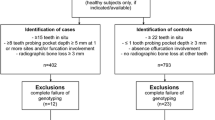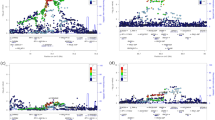Abstract
Buerger disease (BD) is an occulusive vascular disease of unknown etiology. Although cigarette smoking is a well-known risk factor of BD, genetic factors may also play a role in the etiology. Because chronic bacterial infection such as oral periodontitis is suggested to be involved in the pathogenesis of BD, gene polymorphisms involved in the infectious immunity might be associated with BD as the genetic factor(s). We have previously reported that HLA-DRB1*1501 and B54 was associated with BD in Japanese. In this study, polymorphisms in HLA-DPB1, DRB1 and B were analyzed in 131 Japanese BD patients and 227 healthy controls. In addition, we investigated a functional promoter polymorphism, −260 C > T, of CD14 that is a main receptor of bacterial lipopolysaccharide. It was found that the frequencies of CD14 TT genotype [37.4 vs. 24.2%, P = 0.008 OR = 1.87, 95% confidence interval (CI); 1.18, 2.97], DRB1*1501 (34.4 vs. 13.2%, P c = 4.4 × 10−5, OR = 3.44, 95%CI; 2.06, 5.73) and DPB1*0501 (79.4 vs. 55.1%, P c = 4.7 × 10−5, OR = 3.14, 95%CI; 1.93, 5.11) were significantly higher in the patients than in the controls, demonstrating that at least three genetic markers were associated with BD. Stratification analyses of these associated markers suggested synergistic roles of the genetic factors. Odds ratios ranged from 4.72 to 12.57 in individuals carrying any two of these three markers. These findings suggested that the susceptibility to BD was in part controlled by genes involved in the innate and adaptive immunity.
Similar content being viewed by others
References
Adar R, Papa MZ, Halpern Z, Mozes M, Shoshan S, Sofer B, Zinger H, Dayan M, Mozes E (1983) Cellular sensitivity to collagen in thromboangiitis obliterans. N Engl J Med 308:1113–1116
Aerbajinai W, Tsuchiya T, Kimura A, Yasukochi Y, Numano F (1996) HLA class II DNA typing in Buerger’s disease. Int J Cardiol 54(Suppl):S197–S202
Arroyo-Espliguero R, Avanzas P, Jeffery S, Kaski JC (2004) CD14 and toll-like receptor 4: a link between infection and acute coronary events? Heart 90:983–988
Ates A, Yekeler I, Ceviz M, Erkut B, Pac M, Basoglu A, Kocak H (2006) One of the most frequent vascular diseases in northeastern of Turkey: thromboangiitis obliterans or Buerger’s disease (experience with 344 cases). Int J Cardiol 111:147–153
Baldini M, Lohman IC, Halonen M, Erickson RP, Holt PG, Martinez FD (1999) A polymorphism* in the 5′ flanking region of the CD14 gene is associated with circulating soluble CD14 levels and with total serum immunoglobulin E. Am J Respir Cell Mol Biol 20:976–83
Beutler B (2000) Tlr4: central component of the sole mammalian LPS sensor. Curr Opin Immunol 12:20–26
Buerger L (1952) Thrombo-angitis obliterans; a study of the vascular lesions leading to presenile spontaneous gangrene. Am J Med 13:526–532
Chen YW, Iwai T, Umeda M, Nagasawa T, Huang Y, Takeuchi Y, Ishikawa I (2007) Elevated IgG titers to periodontal pathogens related to Buerger disease. Int J Cardiol doi:10.1016/j.ijcard.2006.11.032
Chun YH, Chun KR, Olguin D, Wang HL (2005) Biological foundation for periodontitis as a potential risk factor for atherosclerosis. J Periodontal Res 40:87–95
Dorn BR, Burks JN, Seifert KN, Progulske-Fox A (2000) Invasion of endothelial and epithelial cells by strains of Porphyromonas gingivalis. FEMS Microbiol Lett 187:139–144
Folwaczny M, Glas J, Török H-P, Fricke K, Folwaczny (2004) The CD14 −159C-to-T promoter polymorphism in periodontal disease. J Clin Periodontol 31:991–995
Hada M, Sakihama T, Kamiya K, Tasaka K, Ueno A (1993) Cellular and humoral immune responses to vascular components in thromboangiitis obliterans. Angiology 44:533–540
Hirayama K, Matsushita S, Kikuchi I, Iuchi M, Ohta N, Sasazuki T (1987) HLA-DQ is epistatic to HLA-DR in controlling the immune response to schistosomal antigen in humans. Nature 327:426–430
Hohda S, Kimura A, Sasaoka T, Hayashi T, Ueda K, Yasunami M, Okabe M, Fukuda N, Kurosawa T, Izumi T (2003) Association study of the CD14 polymorphism with myocardial infarction in Japanese populations. Jpn Heart J 44:613–622
Hubacek JA, Pit’ha J, Skodova Z, Stanek V, Poledne R (1999) C(−260)− > T polymorphism in the promoter of the CD14 monocyte receptor gene as a risk factor for myocardial infarction. Circulation 99:3218–3220
Iwai T, Inoue Y, Umeda M, Huang Y, Kurihara N, Koike M, Ishikawa I (2005) Oral bacteria in the occluded arteries of patients with Buerger disease. J Vasc Surg 42:107–115
James JA, Poulton KV, Haworth SE, Payne D, McKay IJ, Clarke FM, Hughes FJ, Linden GJ (2007) Polymorphisms of TLR4 but not CD14 are associated with a decreased risk of aggressive periodontitis. J Clin Periodontol 34:111–117
Kamikawaji N, Fujisawa K, Yoshizumi H, Fukunaga M, Yasunami M, Kimura A, Nishimura Y, Sasazuki T (1991) HLA-DQ-restricted CD4+ T cells specific to streptococcal antigens present in low but not in high responders. J Immunol 146:2560–2567
Kimura A, Kobayashi Y, Takahashi M, Ohbuchi N, Kitamura H, Nakamura T, Satoh M, Sasaoka T, Hiroi S, Arimura T, Akai J, Aerbajinai W, Yasukochi Y, Numano F (1998) MICA gene polymorphism in Takayasu’s arteritis and Buerger’s disease. Int J Cardiol 66(Suppl 1):S107–S113
Kobayashi M, Nishikimi N, Komori K (2006) Current pathological and clinical aspects of Buerger’s disease in Japan. Ann Vasc Surg 20:148–156
Kondo T, Ohno M, Shimokata K, Iino S, Inden Y, Murohara T, Hirai M (2003) CD14 promoter polymorphism is associated with acute myocardial infarction resulting from insignificant coronary artery stenosis. Heart 89:931–932
Laine ML, Morré SA, Murillo LS, von Winkelhoff A-J, Peña AS (2005) CD14 and TLR4 gene polymorphisms in adult peiodontitis. J Dent Res 84:1042–1046
McCluskey J, Peh CA (1999) The human leukocyte antigens and clinical medicine: and overview. Rev Immunogenet 1:3–20
Numano F, Sasazuki T, Koyama T, Shimokado K, Takeda Y, Nishimura Y, Mutoh M (1986) HLA in Buerger’s disease. Exp Clin Immunogenet 3:195–200
Ohyama H, Takashiba S, Oyaizu K, Nagai A, Naruse T, Inoko H, Kurihara H, Murayama Y (1996) HLA class II genotypes associated with early-onset periodontitis: DQB1 molecule primarily confers susceptibility to the disease. J Periodontol 67:888–894
Olin JW (2000) Thromboangiitis obliterans (Buerger’s disease). N Engl J Med 343:864–869
Saito S, Ota S, Yamada E, Inoko H, Ota M (2000) Allele frequencies and haplotypic associations defined by allelic DNA typing at HLA class I and class II loci in the Japanese population. Tissue Antigens 56:522–529
Sengar DP, Hampton N, Goldstein R, Sengar AS (1995) Comprehensive typing of HLA-DPB1 alleles by polymerase chain reaction-restriction fragment length polymorphism (PCR-RFLP). Clin Invest Med 18:465–472
Stein J, Reichert S, Gautsch A, Maculla HKG (2003) Are there HLA combinations typical supporting for or making resistant against aggressive and/or chronic periodontitis? J Periodont Res 38:508–517
Svejgaard A, Ryder LP (1994) HLA and disease associations: detecting the strongest association. Tissue Antigens 43:18–27
Takahashi M, Kobayashi Y, Ichiki M, Ouchi H, Numano F, Kimura An (1999) HLA-linked susceptibility and resistance to Buerger’s disease in Japanese. MHC 5:7–12
Takashiba S, Ohyama H, Oyaizu K, Kogoe-Kato N, Maruyama Y (1999) HLA genetics for diagnosis of susceptibility to early-onset periodontitis. J Periodont Res 34:374–378
Tanaka K (1998) Pathology and pathogenesis of Buerger’s disease. Int J Cardiol 66(Suppl 1):S237–S242
Vainas T, Stassen FRM, Bruggeman CA, Welten R, van den Akker L, Kitslaar P, Pena AS, Morre SA (2006) Synergistic effect of Toll-like receptor 4 and CD14 polymorphisms on the total atherosclerosis burden in patients with peripheral arterial disease. J Vasc Surg 44:326–332
Acknowledgments
This work was supported in part by grants-in-aids from the Ministry of Education, Culture, Sports, Science and Technology (MEXT) Japan. We thank staffs in vascular surgery department of Tokyo Medical and Dental University for the sample collection.
Author information
Authors and Affiliations
Corresponding author
Rights and permissions
About this article
Cite this article
Chen, Z., Takahashi, M., Naruse, T. et al. Synergistic contribution of CD14 and HLA loci in the susceptibility to Buerger disease. Hum Genet 122, 367–372 (2007). https://doi.org/10.1007/s00439-007-0408-1
Received:
Accepted:
Published:
Issue Date:
DOI: https://doi.org/10.1007/s00439-007-0408-1




